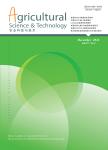版权所有:内蒙古大学图书馆 技术提供:维普资讯• 智图
内蒙古自治区呼和浩特市赛罕区大学西街235号 邮编: 010021

作者机构:中国农业科学院哈尔滨兽医研究所兽医生物技术国家重点实验室禽传染病研究室黑龙江哈尔滨150001 山东新希望六合有限公司山东青岛266000 江苏省动物重要疫病与人畜共患病协同创新中心江苏扬州225009
出 版 物:《Agricultural Science & Technology》 (农业科学与技术(英文版))
年 卷 期:2015年第16卷第8期
页 面:1565-1569,1602页
学科分类:090601[农学-基础兽医学] 09[农学] 0906[农学-兽医学]
基 金:Supported by National Natural Science Foundation of China(No.31430087) the Application Technology Research and Development Fund of Harbin(no.2014AB3AN058) the Special Fund for Scientific and Technological Innovative Talents of Harbin(No.2014RFQYJ129) the Modern Agro-industry Technology Research System of China(No.nycytx-42-G3-01)
主 题:Genetic analysis VP2 Infectious bursal disease virus
摘 要:[Objective] Infectious bursal disease (IBD) is a highly contagious immuno- suppressive disease caused by infectious bursal disease virus (IBDV). IBDV is ge- netically prone to mutation, which results in challenges to the disease prevention and control. Thus, it is necessary to continuously monitor the prevalence of IBDV. [Method] 36 IBDVs were identified from ten provinces in China from 2009 to 2012. Partial fragments of VP2, including the hypervariable region (HVR), from new iso- lates were sequenced and analyzed through comparisons with published sequences of IBDV, including 18 strains isolated previously by our lab and 24 reference strains from China and around the world. [Result] Phylogenetic analysis showed a co-exis- tence of IBDV strains belonging to classic, variant, attenuated, and very virulent IB- DV (wlBDV) in China. wlBDVs remain the predominant strains in China and the new subgroup was emerging. Alignment analysis revealed several distinct amino acid mutations that might be involved in virulence or antigenicity variation. [Conclu- sion] The results offered evolutionary clues showing the emerging trend of obvious variations and diversity of IBDV in major poultry-producing regions of China particu- larly in recent years. These findings will contribute to a better understanding of the genetic evolution of IBDV.